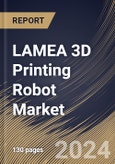AI integration is reshaping the capabilities of these robots. Smart algorithms optimize printing processes, predict potential errors, and enhance overall efficiency. AI-driven design tools also aid in creating complex geometries and structures, pushing the boundaries of what can be achieved with 3D printing. AI's predictive capabilities are crucial in mitigating potential errors and enhancing the reliability of these robots. Using historical data and real-time sensor inputs, AI algorithms can forecast the imminent failure or maintenance needs of 3D printer components.
In addition, the ability to print with multiple materials simultaneously is a trend gaining traction in the market. This facilitates the fabrication of composite structures exhibiting diverse mechanical properties, thereby expanding the potential for final products that are both functional and adaptable. Likewise, the concept of remote printing and decentralized manufacturing is gaining prominence. This trend leverages the connectivity of these robots, allowing for the production of components at or near the point of use. This reduces transportation costs and facilitates a more distributed and resilient manufacturing ecosystem.
LAMEA has been experiencing economic growth and increased industrialization. As industries in the region expand, there is a growing demand for innovative manufacturing technologies, including these robots, to enhance production processes and efficiency. The growth of manufacturing and automotive sectors in countries within LAMEA is a key driver for adopting these robots. These robots offer advantages such as rapid prototyping, customization, and cost-effective production, making them attractive for industries seeking to modernize their manufacturing processes. Therefore, increasing automotive sector and industrialization in LAMEA region will boost the demand for these robots in the region.
The Brazil market dominated the LAMEA 3D Printing Robot Market by Country in 2022, and would continue to be a dominant market till 2030; thereby, achieving a market value of $87.5 million by 2030. The Argentina market is showcasing a CAGR of 18.1% during (2023 - 2030). Additionally, The UAE market would register a CAGR of 17.1% during (2023 - 2030).
Based on Component, the market is segmented into Robot Arms, 3D Printing Heads, and Software. Based on Application, the market is segmented into Prototyping, Tooling, and Functional Part Manufacturing. Based on Robot Type, the market is segmented into Articulated Robots, Cartesian Robots, Scara Robots, Polar Robots, Delta Robots, and Others. Based on End User, the market is segmented into Aerospace & Defense, Construction, FMCG, Culinary, Automotive, and Others. Based on countries, the market is segmented into Brazil, Argentina, UAE, Saudi Arabia, South Africa, Nigeria, and Rest of LAMEA.
List of Key Companies Profiled
- Kuka AG (Midea Group Co., Ltd.)
- ABB Group
- Yaskawa Electric Corporation
- FANUC Corporation
- Universal Robots A/S (Teradyne, Inc.)
- Massive Dimension
- CEAD B.V.
- Caracol
- Meltio3D
- Comau S.p.A. (Stellantis N.V.)
Market Report Segmentation
By Component- Robot Arms
- 3D Printing Heads
- Software
- Prototyping
- Tooling
- Functional Part Manufacturing
- Articulated Robots
- Cartesian Robots
- Scara Robots
- Polar Robots
- Delta Robots
- Others
- Aerospace & Defense
- Construction
- FMCG
- Culinary
- Automotive
- Others
- Brazil
- Argentina
- UAE
- Saudi Arabia
- South Africa
- Nigeria
- Rest of LAMEA
Table of Contents
Companies Mentioned
- Kuka AG (Midea Group Co., Ltd.)
- ABB Group
- Yaskawa Electric Corporation
- FANUC Corporation
- Universal Robots A/S (Teradyne, Inc.)
- Massive Dimension
- CEAD B.V.
- Caracol
- Meltio3D
- Comau S.p.A. (Stellantis N.V.)








